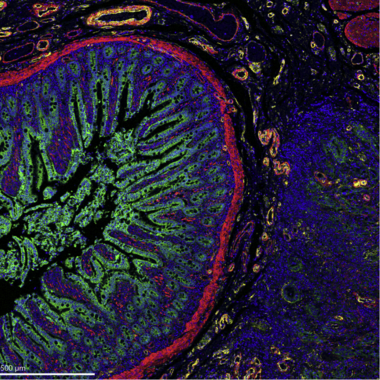Handling high-plex imaging data can pose a challenge, but these groundbreaking user-developed tools can give you the edge you need to answer translational and clinical research questions.
There are so many different image analysis approaches and tools, how do you choose the one that’s right for you?
Standard BioTools offers a recommended pipeline for data analysis, which now includes integrated AI-driven analysis from Visiopharm®. Visit this blog post to learn more about this exciting new partnership and how Phenoplex™, an analysis software that has been paired with the Hyperion™ and Hyperion+ Imaging Systems, provides a powerful, streamlined sample-to-analysis workflow solution for high-plex data.
We recognize and support cytometry experts who are contributing to and developing tailored data analysis approaches.
In the second session of our latest IMC™ Forum, Considerations for High-Plex Imaging Data Analysis, four trailblazers presented their high-plex analytical tools. The Forum provides an opportunity to see what’s being used in high-impact publications and learn from Imaging Mass Cytometry™ expert users.
Denis Schapiro, PhD, is a group leader at the University Hospital in Heidelberg, where his lab focuses on single-cell resolved spatial omics analysis. During his doctoral and postdoctoral research at the University of Zurich, Schapiro led the team in developing histoCAT, a computational toolbox. He has also developed a new tool, MCMICRO.
histoCAT was one of the first tools to address needs for highly multiplexed image analysis. It’s a web platform that allows users to interactively visualize and analyze multiplexed imaging cytometry data, enabling exploration of cell phenotypes, cell-cell interactions, microenvironments and morphological structures. The newest version of histoCAT, v1.9, will work on the most recent Mac and Windows operating systems and is migrating to a newer MATLAB version. Among other updates, v1.9 will include a headless mode, allow direct import and export of .csv and FCS files and direct integration with other available tools and permit loading of pyramid TIFFs for improved performance.
When you’re dealing with massive image datasets, there is no scalable, modular workflow available for multiplexed whole slide image analysis. MCMICRO bridges that gap. An open source software that creates pipelines for analyzing microscopy-based images of tissues, MCMICRO processes data sequentially using algorithms, or modules, developed in different research groups, implementing a “multiple choice” approach that allows users to select different modules for customized image processing.

Antonios Somarakis, PhD, is a computational scientist with The Jackson Laboratory. He develops novel pipelines in the area of single-cell data science, particularly working to overcome the challenges stemming from the analysis of spatially resolved omics data. During his time as a postdoctoral researcher at the University of Leiden, he led the effort to develop ImaCytE.
Somarakis was motivated to develop ImaCytE as a result of discussions with clinicians and biologists about what research questions they wanted to answer: They all wanted to identify and explore cellular microenvironments and determine why a cell with specific characteristics would be in close proximity to a cell with other specific characteristics. Somarakis aimed to create a GUI tool that would be suitable for domain experts to use, with no coding needed, and would provide interactive data exploration. The ImaCytE workflow allows users to preprocess data, identify different cell types and focus on exploring the cellular microenvironment, which constitutes the main part of IMC data exploration.

As the high-dimensional cytometry specialist at the Sydney Cytometry Core Research Facility, Tom Ashhurst, PhD, leads the development and application of high-dimensional cytometry, imaging and single-cell sequencing technologies. Ashhurst was instrumental in building the analysis toolkit Spectre.
During his PhD, Ashhurst and his team were looking at mouse models of viral encephalitis and exploring the location of immune cells in the brain, and ended up incorporating Imaging Mass Cytometry technology into their work in order to better track infection through the central nervous system. After discussions with colleagues who were performing spatial analysis and wanting an approach that was similar to their everyday work, Spectre was developed. It’s a computational toolkit in the programming language R used for the integration, exploration and analysis of high-dimensional single-cell cytometry data. Spectre has a focus on ease of use, efficient processing of large datasets, simple and flexible data structures and incorporating alignment/integration strategies.

Nicolas Damond, PhD, is a postdoctoral researcher at the University of Zurich, where he has continued his work understanding type 1 diabetes and used his programming and image analysis skills in the development of cytomapper.
Multiplex imaging technologies generate a lot of data, thanks to things like an abundance of markers and spatial and neighborhood information. In order to analyze this complex data, many tools have been developed in R. However, since R was created as a statistical language, it can be hard to use for visualizing images. This is where cytomapper comes in. cytomapper allows users to directly visualize multiplex images and cell information in R. You can see pixel-level and cell-level information and even combine the two, plotting cell outlines on top of images. The tool also includes a Shiny application that allows hierarchical gating of cells. And the R/Bioconductor package imcdatasets provides easy, direct access to curated and formatted IMC datasets.

Handling high-plex imaging data can sometimes pose a challenge, but these groundbreaking user-developed tools can give you the edge you need to gain a deeper understanding of the spatial environment to answer important translational and clinical research questions in the context of disease.
Unless explicitly and expressly stated otherwise, all products are provided for Research Use Only, not for use in diagnostic procedures. Find more information here.
